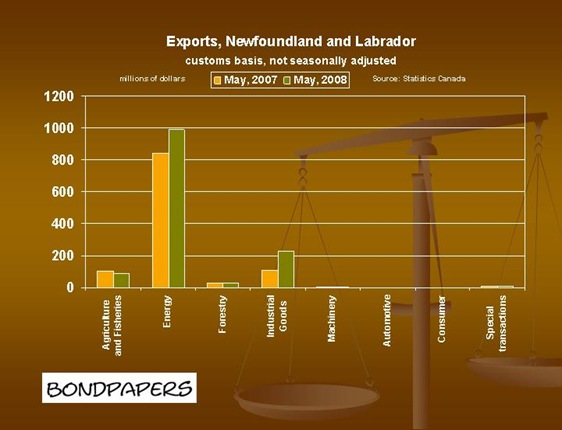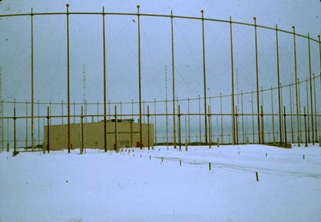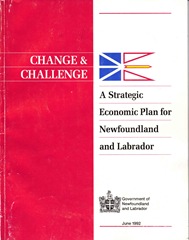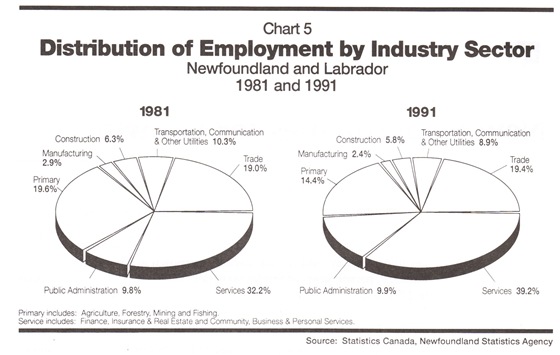 The traditional primary resource industries do not offer significant potential for large-scale employment and growth at this time. Even to maintain our current position in export markets we must improve our competitiveness through increased training and the application of new technologies. Nevertheless, new economic benefits will grow from our present resource industries as we expand processing within the Province, thereby adding value to our products.
The traditional primary resource industries do not offer significant potential for large-scale employment and growth at this time. Even to maintain our current position in export markets we must improve our competitiveness through increased training and the application of new technologies. Nevertheless, new economic benefits will grow from our present resource industries as we expand processing within the Province, thereby adding value to our products.
Fisheries
The fishing industry is a major contributor to the Newfoundland and Labrador economy. The industry accounted for 19% of the GDP in the goods-producing sector and 5.5% of total GDP in 1990. Total landings of 540,000 tonnes (all species) in 1990 provided products valued at approximately $650 million, though in 1991 landings dropped to 380,000 tonnes worth $570 million. The fishery provides about 10% of total provincial employment measured in person years.
Today, the Newfoundland fishery is experiencing a crisis arising from the collapse of the resource base which will have the effect of accelerating the process of structural adjustment. This is particularly true for groundfish operations in both the inshore and offshore sectors.
Policies and programs must be developed which will help guide the fishery through its current crisis and toward a more viable future. Key concerns are resource conservation and rebuilding, and federal/provincial policy co-ordination. A further challenge to government is to promote the development of an economically viable and competitive fishery while at the same time providing training and education, and encouraging the development of alternative economic opportunities for the people in the numerous communities which in the past have depended solely on the fishery.
Resource conservation and rebuilding of vitally important groundfish stocks will only be possible through effective control of harvesting by foreign vessels outside the 200-mile Canadian fisheries management zone. In 1991, for example, foreign fishing fleets took more than six times their allowable quotas, and overfished six critical groundfish stocks by about 90,000 tonnes. Such uncontrolled harvesting effort is directly contributing to a major decline in Canadian quotas and is largely responsible for both temporary and permanent closures of Newfoundland groundfish operations.
Canada/Newfoundland policy co-ordination, as envisaged by Newfoundland's joint management proposal, is critical to a well-planned fisheries revitalization and development strategy. Such an approach would provide for the co-ordination of fisheries responsibilities of both governments, facilitate provincial economic policy formation and implementation, create a fair and transparent fisheries management system, and prevent erosion of access to fisheries resources adjacent to the Province.
Strategy Statement. The Province will initiate a fisheries action program which will strengthen the fishery and the economy generally. A viable fishery is one which is stable and competitive in the absence of government subsidies, where a reduced fisheries workforce can earn an adequate income without excessive dependence on income support, and where the workforce can be professionalised to obtain high productivity levels.
This action program involves two broad elements: first, the revitalization of the fishery itself, and second, diversification within and outside the fishery. Fishery revitalization will include measures to rebuild and protect the resource base, to restore and preserve the environment as it relates to fishery resources, and to increase economic efficiency through improved operational flexibility, capacity control, technological innovation and better quality control. Education and training of industry participants will be an integral part of the entire fishery revitalization program. Diversification will focus on new opportunities in secondary processing, aquaculture, and the harvesting and processing of underutilized fishery resources.
Actions. The Province will
96. Aggressively pursue the implementation of a joint fisheries management board (modeled on the Canada/Newfoundland Offshore Petroleum Board) whereby a comprehensive development plan can be put into effect.
97. Increase efforts to develop a long-term strategy to deal with foreign overfishing through an international public awareness program.
98. Cost share, in conjunction with the Federal Government, a major research initiative on the life cycle and behaviour of the commercial fish stocks off our coasts in order to avoid resource crises such as the present one, and to provide the information needed to develop long-term policy and program decisions.
99. In cooperation with the Federal Government, implement a salmon river enhancement program to rebuild and protect the salmon stock and thus stimulate a major expansion of this economically important recreational fishery.
100. Accelerate education programs for people now engaged in the fishery. This will include two components: a community-based program aimed at people leaving the industry, which will include literacy training and basic education; and management and technical training for people staying in the fishery. For the latter, such training will be a prerequisite to receiving Government funding
under various development programs.
101. Assist the industry to achieve higher levels of technological innovation and improved management in both the harvesting and processing sectors.
102. Provide assistance to undertake more diversification of the fish processing industry, emphasising value-added processing and the utilization of by-products, and assist with cooperative marketing arrangements to enhance the success of smaller-scale value-added operations. Specific initiatives will include international promotion of joint venture opportunities, assistance for locally based manufacturing to produce items such as specialty containers to be used in
secondary processing, and consideration of an incubator facility to assist small, fledgling companies.
103. Establish a Seafood Promotion Council, consisting of private-sector and government representatives, to undertake a generic promotion campaign.
104. Escalate research, development and marketing efforts in support of a viable sealing industry. Emphasis will be placed on using the entire animal.
105. Increase efforts to develop and expand the aquaculture industry by
- initiating a mussel production incentive to boost production by a
million pounds a year by 1994; - accelerating the development of scallop hatchery technology with
the objective of constructing such a hatchery; - seeking additional research and development funding to investigate and develop the potential of species such as arctic char, cod, halibut and ocean pout;
- establishing a Ministerial Advisory Council on Aquaculture, composed of representatives of the industry, academic and research organizations, and government;
- establishing environmental guidelines to expand the use of freshwater lakes for aquaculture;
- streamlining the format for applications for new licenses within
the aquaculture industry; and - taking action to stem the discharge of raw sewage into waters
which have potential for aquaculture development.
106. Amend regulations in order to improve the quality of fish at dockside, and provide for the mandatory gutting of cod, containerized storage of crab on vessels and the banning of prongs for handling fish.
107. Streamline and change the policies and programs of the Fisheries Loan Board to
- better co-ordinate efforts with federal activities;
- entertain proposals from non-traditional areas, such as
aquaculture; and - provide a special incentive program for vessel acquisition in
Labrador.
108. Where possible, lease marine services centres to private-sector companies or community-based organizations to improve cost effectiveness and generate local commercial activity.
109. Undertake a wide variety of exploratory fishing to identify prospects for diversification. Cod and turbot adjacent to northern Labrador will be investigated, and increased landings will be used to supply fish to new, but resource-short plants in Makkovik and Nain. Where possible, local residents will crew the vessels used in these projects so that they can benefit from training and technology transfer.
Forestry
For centuries our forests have been a natural renewable resource from which people of this Province have derived income and other benefits. The rural economy is interwoven with the use of the forests for heating, home building, boat building, wharf construction, hunting, trapping and recreation. Three pulp and paper mills and hundreds of small sawmills have also provided a steady source of income for many people over the years. Currently, the forest industry involves both primary activities, including harvesting and forest management, and secondary processing of wood into such products as newsprint and lumber.
The industry accounted for about 10% of output in the goods-producing sector and 2.9% of total GDP in 1990. It also accounts for about one-third of the manufacturing in the Province. The forest industry provides 3,600 person years of employment annually, though much of this is seasonal or part-year. In recent years, however, there has been a trend toward fewer jobs but less seasonality. Employment in harvesting is declining because of mechanization, but is expanding in silviculture. In the newsprint mills, employment is expected to fall somewhat further until the industry has become more efficient, productive and competitive. The result, however, will be a stronger, more viable industry which will provide more stable incomes for the future.
The Province depends almost entirely on export markets for its newsprint, but all lumber production is consumed locally. Nevertheless, investments are now being made to produce lumber for European markets.
Over the past five years, two of the pulp and paper mills in the Province have been modernized to improve quality, increase efficiency and reduce pollution. Approximately $227 million has been invested in the Corner Brook mill and approximately $47 million in the Grand Falls mill. (The third mill, at Stephenville, was already a modern facility.) However, considerably more investment is needed at both locations to continue to improve upon the quality of product, mill efficiency and environmental compliance.
While the pulp and paper industry accounts for approximately 75% of the economic activity in forestry, sawmilling, commercial fuelwood, resource management and protection, and converted wood-products industries also occupy essential roles, particularly in maintaining the economic well-being of many rural communities. Many other elements, such as wildlife, watersheds, recreation and tourism, also depend on our forest lands.
The Department of Forestry and Agriculture is now in the second five years of its 20-year planning process. This Forestry Development Plan provides an assessment of the current state of the forests and sets forth a strategic action program. The following strategy and actions draw on this strategic action program.
Strategy Statement. The Province will manage its forests through integrated forest management and according to the principles of sustainable development, incorporating multiple use values such as protecting recreational areas, watersheds and wildlife habitat. Public consultation and participation will be sought for decisions on management of the forest ecosystem.
Actions. The Province will
110. Give priority to providing additional funding to implement an expanded long-term silviculture program, including programs financed through cost-shared agreements with the Federal Government and the forest industry.
111. Through the new Forestry Act, designate a suitable forest land base for timber production to maintain a viable forest industry in conjunction with other uses and benefits.
112. Enhance our capability to practise integrated forest management by forming stakeholder partnerships and committees, public consultation, staff training and collaboration with education and training institutions, such as the Centre for Forestry and Environmental Studies at the Fisher Campus of the Western Community College and the forestry program at Memorial University.
113. Maximize the use of the forest resource, and maintain and improve the competitive position of the forest products industry. More specifically the Province will ensure that
- sawmills with integrated operations producing lumber, chips and/or pulpwood receive preference in wood allocation;
- further arrangements will be made, wherever possible, with the pulp and paper industry to increase the supply of sawlogs to the sawmilling industry;
- harvesting of wood for domestic use will be regulated to ensure that it does not interfere with the commercial use of the resource;
- the sawmilling industry will be supported by providing training, technology transfer and continued financial support; and
- the forest products industry will be supported to improve its efficiency and to identify opportunities for diversification into higher value products.
114. Provide adequate financial resources to protect the forest resource from damage by insects, fires and diseases.
115. Provide additional funding for forest access roads to achieve maximum use of all available forest resources.
116. Expand the private woodlot management program by involving individuals, groups and communities which have the money and skills to invest in managing the resource.
117. Work with the private sector to establish a forest-based industry in Labrador. This will require conducting forest inventories and investing in roads and other infrastructure in the Happy Valley-Goose Bay and Cartwright areas.
Mining
The mining industry continues to be one of the leading resource-based industries in the provincial economy and is expected to continue in that role into the foreseeable future. The industry accounted for approximately 11% of our GDP in the goods-producing sector and 3.2% of total GDP in 1990.
A diverse range of mineral commodities is produced by the mining industry, though iron ore production dominates, accounting for more than 90% of the total value of mineral shipments during 1991. The Province has two iron ore producers, both of which are located in Labrador. These two producers employed more than 2,400 people in the Province in 1991.
The output of the Newfoundland and Labrador mining industry is shipped primarily to markets located outside Canada. The industry continues to suffer from the current global economic recession, however, and this has resulted in decreased demand and lower prices for mineral commodities and metals. This general trend, with some exceptions, is expected to continue throughout 1992.
New opportunities exist in gold and base-metal mining, in developing dimension stone and slate industries, for limestone, dolomite and marble production and in peat development. Further processing of mineral resources in the Province is also dearly desirable. As the potential for the development of industrial minerals increases - dimension stone in particular - opportunities for further processing will emerge and will be diligently pursued.
Generally, the high cost of infrastructure for new mining projects, the relatively high total tax burden on the mining industry, and the inadequate levels of funding for mineral exploration are major constraints to mineral development. Government, however, is assisting mineral exploration through a continuing program of geoscientific surveys. The data collected to date have been a major factor in attracting mineral exploration investment to the province and have led to the discovery of several deposits.
Strategy Statement. The Province will establish a better investment climate to attract exploration and development. It will also continue geoscientific surveys to stimulate mineral exploration through the identification of prospective areas, and to provide the geological data required for economic development generally.
Actions. The Province will
118. Establish a mining infrastructure fund to assist industry with the funding of hydro lines, access roads, shipping facilities and other infrastructure for new mining developments.
119. Establish an exploration assistance program to provide for cost sharing of drilling and other advanced exploration projects by local prospectors and Newfoundland junior exploration companies in order to develop local mining entrepreneurs.
120. Amend The Mineral Act and regulations to facilitate and encourage mineral exploration. In particular, assessment expenditure requirements in Labrador will be reduced and annual rentals on mineral licences will be eliminated.
121. Prepare, in consultation with the mining industry, a new Mining Act
which will establish rights and obligations concerning such issues as environmental liabilities for abandoned mines, mine closure plans, rehabilitation of mine sites and ultimate long-term liability of mine operators.
122. Expand the Geological Survey Program of the Department of Mines and Energy to promote development of specific mineral commodities, areas and deposits. Particular attention will be given to the emerging dimension stone industry in Newfoundland and Labrador.
123. Encourage and promote, where possible, further value-added processing of mineral resources and mineral-related manufacturing opportunities in the Province within existing operations, and in future mineral developments as they occur.
124. Expand cooperative initiatives with the Centre for Earth Resources Research (CERR) at Memorial University to make earth sciences expertise more available to the mineral industry.
125. Promote our mineral resources that are near to coastal shipping and therefore have an advantage when competing in international markets.
Agrifoods
Agriculture in one form or another has had a long history in our Province. The raising of livestock can be traced back to the Vikings who lived at L'anse aux Meadows, and root crops were planted to supplement the diets of the first permanent European settlers. From these early beginnings, an industry has grown which contributed approximately $62 million to the economy in 1991 at the farm gate. Even though agriculture production accounts for less than 1% of our total GDP, The Report of the Task Force on Agrifoods estimates that the value of the industry may be as high as $300 million when food processing, transportation and retailing are included.
Livestock and poultry accounted for 80% of farm cash receipts in 1991 ($50 million) and this percentage has been fairly consistent over the years. The major livestock and poultry commodities, measured by farm cash receipts, are dairy products, broilers, eggs and hogs. Other commodities include beef, sheep and fur.
Vegetables, potatoes, fruit and floriculture/greenhouse products represent about 16% of farm cash receipts ($10 million). Floriculture/ greenhouse production was the largest contributor, followed by strawberries and potatoes. The most important vegetables include turnips, cabbage, carrots and beet, though production of broccoli, cauliflower and lettuce is increasing.
This industry generates approximately 1,600 person-years of employment annually. It is important as a source of employment in some rural areas of the Province and as a food source for all residents. Although much of the food consumed in the Province is imported, local production reduces the Province's dependence on imports and helps to ensure that fresh and healthful products are available in all parts of the Province.
The recommendations of the Task Force on Agrifoods are an integral part of the Department's plans for agricultural development. Its Report identified a number of opportunities for expansion. Some of these include production of poultry (both chicken and turkey), dairy products, sheep, fur (including non-traditional species), fruit and vegetables, and secondary processing in all areas. The Report also stressed the need to protect an adequate land base for viable agriculture.
The future of agriculture production in Newfoundland and Labrador will rest largely on the industry's efficiency and competitiveness. Potential changes in the international trading environment through the General Agreement on Tariffs and Trade may have implications for supply-managed commodities (dairy products, eggs, poultry) if import protection levels are eroded. Consequently it is prudent for governments and industry to focus on development initiatives which promote efficiency and competitiveness.
Strategy Statement. The Province will implement an action program designed to achieve greater self-sufficiency in locally produced products and to increase the industry's efficiency and competitiveness.
Actions. The Province will
126. Establish a provincial meat inspection program so that livestock can be processed at various local, privately owned plants throughout the Province and marketed through retail stores.
127. Ensure a competitively priced supply of feed to livestock, poultry and fur producers by
- securing improvements to the Feed Freight Assistance Program (FFA);
- expanding research and trials using local feed sources, such as seal meat and fish offal;
- expanding assistance programs to increase local forage production and improve its quality;
- providing assistance to farms to adopt new technology to improve feed efficiencies; and
- rationalizing the number, improving the fertility and expanding the economic base of selected regional pastures.
128. Ensure an adequate land base for viable agriculture by
- purchasing additional agricultural land in the St. John's Urban Region and expanding the program to other areas of the Province; and
- extending agriculture zoning to areas of the Province besides the St. John's Urban Region and the Wooddale Region.
129. Expand funding of the Provincial School Milk Program.
130. Enhance agrifood management, marketing and promotional capabilities by
- expanding farm business management training;
- assisting the formation of organizations to promote cooperative marketing;
- assisting interested individuals and groups to carry out market and feasibility studies, especially to explore non-traditional markets and opportunities in the area of value-added secondary processing; and
- continuing to fund promotional efforts, such as the Food and
Livestock Show and regional fairs.
131. Legislate an equitable and standard municipal tax structure for farms.
132. Increase the supply of capital to the agrifoods industry by raising farm loans ceilings and by instituting a loan guarantee program.
133. Expand production of root crops by assisting farmers with storage facilities, further land development and land improvement.
134. Re-deploy existing human and financial resources to support the above actions.
-srbp-
Chapter Seven - Implementation






